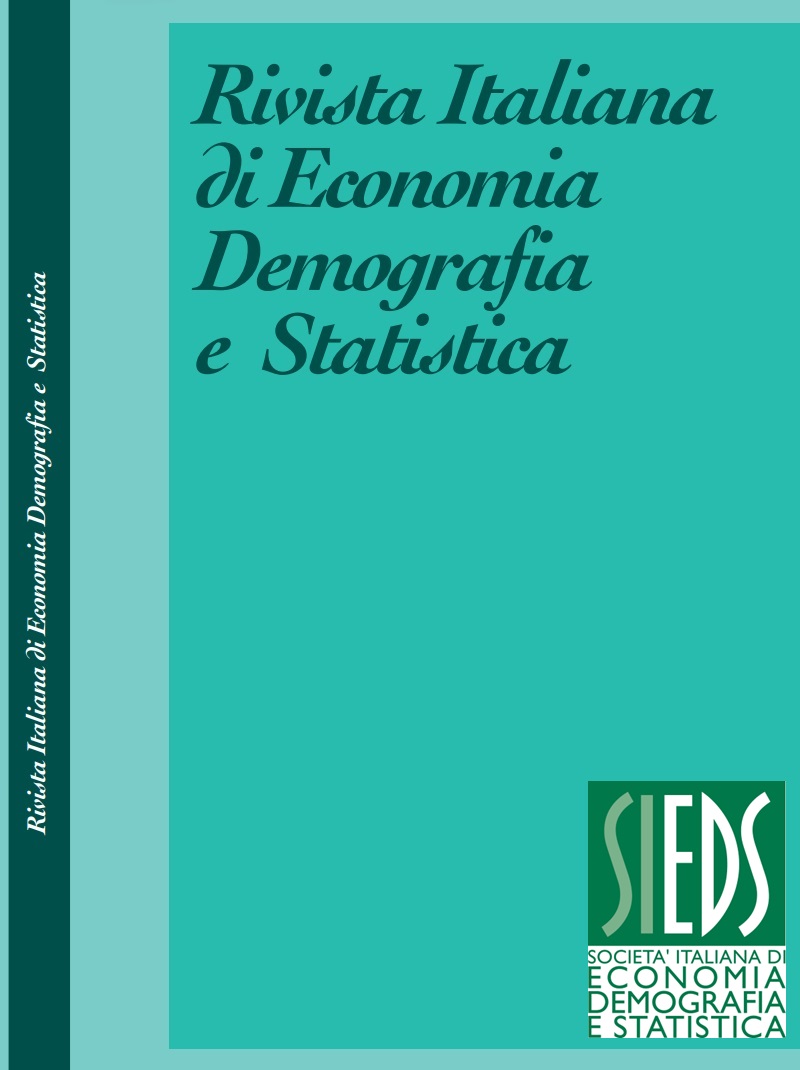Does measurement error bias employment pathways? The case of Italy
DOI:
https://doi.org/10.71014/sieds.v79i1.325Keywords:
mixture hidden Markov model, employment status, measurement error, multi-source dataAbstract
The exploration of employment trajectories over time may be significantly biased due to measurement errors in the data used for the analysis. This paper addresses this issue by employing a mixture hidden Markov model (MHMM) that detects and corrects for measurement errors. Specifically, we use an MHMM that includes two indicators for employment status, derived from linked data from the Italian Labour Force Survey and Administrative Data for the period 2017-2021.
References
ABBOTT A. 1983. Sequences of Social Events: Concepts and Methods for the Analysis of Order in Social Processes, Historical Methods: A Journal of Quantitative and Interdisciplinary History, Vol. 16, No. 4, pp. 129-147. DOI: https://doi.org/10.1080/01615440.1983.10594107
AISENBREY S., FASANG A.E. 2017. The Interplay of Work and Family Trajectories over the Life Course: Germany and the United States in Comparison, American Journal of Sociology, Vol. 122, No. 5, pp. 1448-1484. DOI: https://doi.org/10.1086/691128
BAKK Z., KUHA J. 2018. Two-Step Estimation of Models Between Latent Classes and External Variables, Psychometrika, Vol. 83, No. 4, pp. 871-892. DOI: https://doi.org/10.1007/s11336-017-9592-7
BAKKER B.F.M., DAAS P.J.H. 2012. Methodological challenges of register-based research, Statistica Neerlandica, Vol. 66, No. 1, pp. 2-7. DOI: https://doi.org/10.1111/j.1467-9574.2011.00505.x
BALDI C., CECCARELLI C., GIGANTE S., PACINI S., ROSSETTI F. 2018. The Labour Register in Italy: The New Heart of the System of Labour Statistics, Rivista Italiana Di Economia Demografia e Statistica, Vol. LXXII, No. 2, pp. 95-105.
BAUM L.E., PETRIE T., SOULES G., WEISS N. 1970. A Maximization Technique Occuring in the Statistical Analysis of Probabilistic Functions of Markov Chains, The Annals of Mathematical Statistics, Vol. 41, No. 1, pp. 164-171. DOI: https://doi.org/10.1214/aoms/1177697196
BIEMER, P. 2011. Latent Class Analysis of Survey Error. New Jersey: John Wiley Sons. DOI: https://doi.org/10.1002/9780470891155
FILIPPONI D., GUARNERA U., VARRIALE R. 2021. Latent Mixed Markov Models for the Production of Population Census Data on Employment. In PERNA C., SALVATI N., SCHIRIPPA S. (Eds.) Book of short papers SIS 2021, Pearson, pp. 112-117.
GROVES R.M. 2004. Survey errors and survey costs. New Jersey: Wiley.
ISTAT 2006. La rilevazione sulle forze di lavoro: contenuti, metodologie, organizzazione, Istat, Metodi e Norme, Vol. 32, pp. 173-196.
MANZONI A., VERMUNT J. K., LUIJKX R., MUFFELS R. 2010. Memory Bias in Retrospectively Collected Employment Careers: A Model-Based Approach to Correct for Measurement Error, Sociological Methodology, Vol. 40, No. 1, pp. 39-73. DOI: https://doi.org/10.1111/j.1467-9531.2010.01230.x
MATTIJSSEN L., PAVLOPOULOS D. 2019. A Multichannel Typology of Non-standard Employment Careers, Social Science Research, Vol. 77, pp. 101-114. DOI: https://doi.org/10.1016/j.ssresearch.2018.10.001
OBERSKI D.L., KIRCHNER A., ECKMAN S., KREUTER F. 2017. Evaluating the Quality of Survey and Administrative Data with Generalized Multitrait-Multimethod Models, Journal of the American Statistical Association, Vol. 520, pp. 1477-1489. DOI: https://doi.org/10.1080/01621459.2017.1302338
PANKOWSKA P., BAKKER B., OBERSKI D., PAVLOPOULOS, D. 2021. Dependent interviewing: A remedy or a curse for measurement error in surveys?, Survey Research Methods, Vol. 15, No. 2, pp. 135-146.
PAVLOPOULOS D., VERMUNT J.K. 2015. Measuring Temporary Employment. Do Survey or Register Data Tell the Truth?, Survey Methodology, Vol. 41. No. 1, pp. 197-214.
STUDER M., RITSCHARD G. 2016. What matters in differences between life trajectories: A comparative review of sequence dissimilarity measures, Journal of the Royal Statistical Society. Series A: Statistics in Society, Vol. 179, No. 2, pp. 481-511. DOI: https://doi.org/10.1111/rssa.12125
SUDMAN S., BRADBURN N.M., SCHWARZ N. 1995. Thinking about answers: The application of cognitive processes to survey methodology, Quality of Life Research, Vol. 12, pp. 719-720.
TOURANGEAU R., RIPS L.J., RASINSKI K.A. 2000. The psychology of survey response. Cambridge: University Press. DOI: https://doi.org/10.1017/CBO9780511819322
VARRIALE R., ALFO’ M. 2023. Multi-source statistics on employment status in Italy, a machine learning approach, METRON, Vol. 81, No. 1, pp. 37-63. DOI: https://doi.org/10.1007/s40300-023-00242-7
VERMUNT J.K. 2007. Growth models for categorical response variables: standard, latent-class, and hybrid approaches. In VAN MONTFORT K., OUD J., SATORRA A. (Eds.) Longitudinal models in the behavioral and related science, Erlbaum, pp. 139-158. DOI: https://doi.org/10.4324/9781315091655-6
VERMUNT J.K. 2010. Longitudinal Research Using Mixture Models. In MONTFORT K., OUD J.H., SATORRA A. (Eds.), Longitudinal Research with Latent Variables, Springer, pp. 119-152. DOI: https://doi.org/10.1007/978-3-642-11760-2_4
VERMUNT J.K., MAGIDSON J. 2016. Technical Guide for Latent GOLD 5.1: Basic, Advanced, and Syntax. Belmont, MA: Statistical Innovations Inc.
Downloads
Published
Issue
Section
License
Copyright (c) 2025 Dimitris Pavlopoulos, Roberta Varriale, Silvia Loriga

This work is licensed under a Creative Commons Attribution 4.0 International License.



